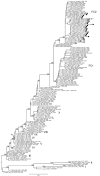Equine influenza A(H3N8) virus isolated from Bactrian camel, Mongolia
- PMID: 25418532
- PMCID: PMC4257804
- DOI: 10.3201/eid2012.140435
Equine influenza A(H3N8) virus isolated from Bactrian camel, Mongolia
Abstract
Because little is known about the ecology of influenza viruses in camels, 460 nasal swab specimens were collected from healthy (no overt illness) Bactrian camels in Mongolia during 2012. One specimen was positive for influenza A virus (A/camel/Mongolia/335/2012[H3N8]), which is phylogenetically related to equine influenza A(H3N8) viruses and probably represents natural horse-to-camel transmission.
Figures


References
-
- Waddell GH, Teigland MB, Sigel MM. A new influenza virus associated with equine respiratory disease. J Am Vet Med Assoc. 1963;143:587–90 . - PubMed
Publication types
MeSH terms
Substances
Grants and funding
LinkOut - more resources
Full Text Sources
Other Literature Sources

